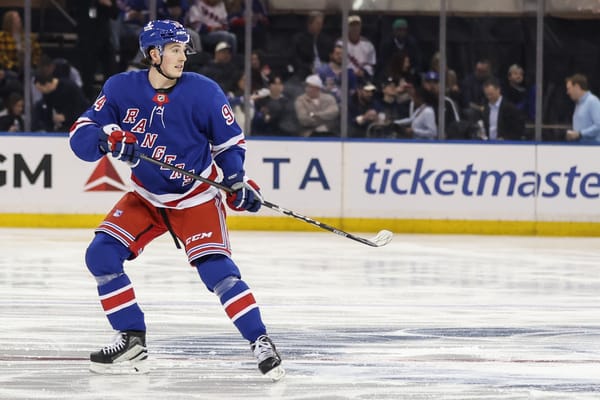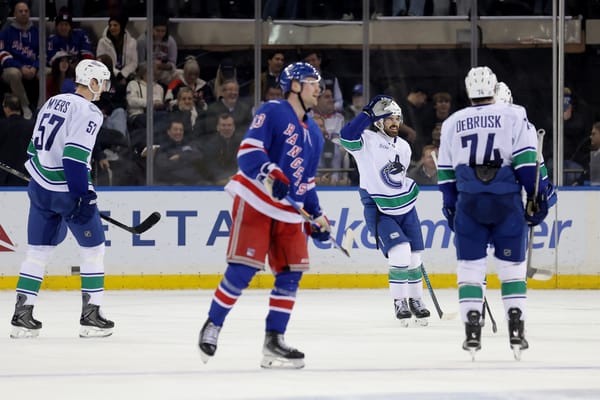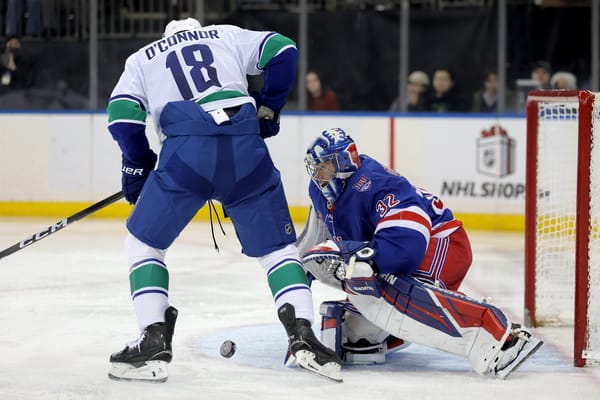The Rangers Are A New Commodity (And It Makes Projecting Their Success Hard)
The Rangers are on their way back from Canada in an interesting position.
On one hand they swept through Canada like wildfire, winning their three games by a combined scored of 14-4. In their victory against Vancouver they hung seven goals on the Canucks on just 18 shots. Kevin Hayes and J.T. Miller were dominant. Mika Zibanejad started finding his groove again. Mats Zuccarello is scoring again, Pavel Buchnevich kept scoring before he got hurt and Henrik Lundqvist has been, well, Henrik Lundqvist. Things have looked great on paper.
On paper ...
I have very mixed feelings about where the Rangers stand right now.
For starters the Rangers are ushering in a new era of hockey ideologies. I know how crazy that is to read, but it’s true. The Rangers have gone from the Tom Renney all defense all the time, to the John Tortorella all defense unless you’re supposed to be blocking shots, to Alain Vigneault’s skill and offense, to Alain Vigneault’s we don’t need a real bottom six and now to a third form of Vigneault which is “we have an unreal offense and a defense put together with staples and glue sticks.”
It’s the former of that final Vigneault form that’s gotten attention. The Rangers are really the first team in this new age of hockey to run four pure skill lines. There is no fourth line of lumbering toughness that’s more prone to punching faces than touching the puck. There’s no bottom six littered with “trusted veterans” who are actually black holes of possession. And, more specifically, there is no defense-first fourth line to soak up those minutes and roles to make space for more offensive players.
Teams that smarty want to balance their bottom-six from their top-six usually either run a top-nine of offense and a fourth line of pure defense, or a top-six of skill and a bottom-six mix.
This year the Rangers play no such games; rather, they run four lines that can be interchanged from top to bottom. When fully healthy the Rangers fourth line is a combination of Jesper Fast, Brandon Pirri, Michael Grabner, Pavel Buchnevich and Oscar Lindberg. It’s OK that you’re smiling right now, because it’s awesome.
The initial results have been impressive. The Rangers have a +34 goal differential through the first 17 games of the year. To put that in perspective the next closest team is the Canadiens with a +18. To put it even more in perspective the Rangers’ +34 differential is higher than Buffalo and Colorado’s total goals scored on the year. It’s an unprecedented amount of offense that comes so fast and furious it leaves you in a high once it’s all said and done.
The Rangers boast the league’s most lethal offense. The. Rangers. Do.
Let’s take a look at the below chart. The left is the Rangers’ current stats. The right is how their current stats project out to each player’s individual full-season pace. I excluded the players in yellow for obvious reasons.
In terms of raw points, Buchnevich is the lowest forward on the list with a pace of just 38 points. However, those totals are adjusted to a 48-game full season (since he’s missed seven games already). Which means his points per game projects out to an 0.80, which is one of the highest on the team.
In terms of points per game, Brandon Pirri and Jesper Fast clock in at the bottom with a 0.59. At that pace both would have a 48-point season. To put that in perspective last year a 48-point season would put both in the top 95 players in NHL scoring. That means the Rangers two worst offense producing forwards (again: the two WORST) would be top-95 players in the NHL in raw scoring last year. All 11 forwards (excluding Buchneivch due to his poor games-played pace) would be in the top 100 for scoring. That’s unprecedented.
Even the defense is getting involved in the party. McDonagh is on pace for a 53-point season (hilariously all assists) and Brady Skjei is on pace for a 48-point season (also all assists). On the podcast last night we got into the Rangers surprise offensive production players, and Skjei and Nick Holden were high on the list. When Nick Holden is pacing for a 43-point year you know things are going right.
So we know the Rangers are good. We know the offense has been historically good. But is this going to be sustainable, especially with the issues the Rangers still have on their top pairing (you know who I’m talking about)?
The below is a series of charts from Sean Tierney (who does great work) showing the Rangers PDO (shooting percentage + save percentage) against their corsi. The Rangers have seen their possession metrics start falling off and their PDO rising. You’d like PDO to remain around 100% and you’d love the corsi to be above 50%. For the Rangers, neither is the case right now.
PDO is climbing as Corsi differential rate dips. pic.twitter.com/WvR9SfGu2g
— Sean Tierney (@ChartingHockey) November 16, 2016
Now, the possession metrics are a little skewed because of just how good the Rangers have been. On the podcast yesterday we discusses that the Rangers have only been involved in four one-goal games this year. They’ve lost three of those (two they should have won and one they deserved to lose) so factor out that single win and the Rangers have won by two or more 12 times. In games where the Rangers are holding a four-goal lead in the second period you’d expect their possession to finish below 50% since, well, what’s the point of making things happen when you’re just trying to put the landing gear down?
Hockey Stat Miner helped alleviate some of these concerns with the below chart:
Looking at #NYR's league ranking in categories, divided into score-state: pic.twitter.com/n29GUNik7D
— HockeyStatMiner (@HockeyStatMiner) November 16, 2016
The good news: When the Rangers are down by a goal they absolutely dominate possession along with every single other metric of note. When they need a goal, they have the offense to get one.
The numbers when tied are concerning. The goals, scoring chance for and expected goals allow you to forget the middle-of-the-road possession figures, but you’d still like to see it higher. There is a running theory that lower corsi can be somewhat ignored in the event the team is still generating a lion’s share of the scoring chances for, which is exactly what the Rangers are doing here.
Up one is what the Rangers have always done: They put the landing gear down and shell.
Any score can be ignored entirely because those figures include the Rangers TOI when they’re up by four or five goals.
The question now remains whether or not the Rangers can keep this up. Joseph Catanzaro helped put together a few running charts of the Rangers rolling averages for expected goals, corsi and scoring chance percentage.
@RangerSmurf @BlueSeatBlogs @BlueshirtBanter But they are trending in the complete wrong direction. Look at the CF% since G came back(10/23) pic.twitter.com/VEdgqN01uF
— Joseph Catanzaro (@JoeCatNYR9) November 16, 2016
In each case the Rangers are slowly trending either back down to earth or worse. This is where the concern lies when you look at the Rangers Canada trip -- where the Rangers got crushed in possession but still managed to win their games by crazy margins.
Last year’s Rangers got off to a historic start, too, but mostly utilized a high shooting percentage to counteract their bad corsi. This year’s Rangers are also seeing players scoring at higher than average shooting percentages (we talked about this on the podcast, too) but the Rangers’ system generates so much in terms of odd man rushes the Rangers are taking higher-impact shots. It should be expected that the Rangers would run and gun with a hot hand.
It also helps the Rangers have the 4th power play in the league and the 7th penalty kill. Winning the special teams battle is critical in games where the offense isn’t getting the job done (this happens when teams have clogged the neutral zone) or the Rangers have needed to rely on their power play to get them going. It’s another weapon the Rangers simply didn’t have last year, and it’s something that you don’t see dramatically changing unless something happens.
To be clear, this year’s team is much more equipped to sustain a higher level of play at even strength than last year’s group. The Rangers have so much skill up and down their lineup that it doesn’t matter when guys slump. For example: Rick Nash, Jimmy Vesey and Mika Zibanejad were the heroes early on in the year. When they went quiet, Pavel Buchnevich, Derek Stepan and Kevin Hayes have stepped up. Michael Grabner and J.T. Miller have been constants. The offense is getting a ton of scoring from McDonagh, Skjei and even Holden to fill in the holes.
Every single team wants something like this to happen. Every single team tries to plan for this to happen. It turns out the solution is remarkably simple: If you play all skill, math will eventually even things out. The law of averages is the king and you can’t kill him. Move on and try again.
So the Rangers -- at least on one end of the ice -- have joined him. And since we’ve never really seen this before, it’s hard to project if the Rangers will be able to sustain this level of play.
As of right now the Rangers have managed to keep their defense in the closet as they party in the living room. “No, don’t go in there, hang out with me and let’s score some goals together.”
Dan Girardi has fallen back into last year’s rut. Holden has slowly pulled himself from his hole and is improving. Skjei’s possession numbers could be better, but his offense has shined through and he’s been spectacular to watch. Marc Staal has seen an improvement. McDonagh has been a beast. Kevin Klein has quietly slipped from last year’s level — not shocking when you realize he played with Keith Yandle A LOT last year. Adam Clendening continues to rot in the press box.
So, yeah, things are going great. There’s a monster in this Rangers locker room and it is the reality that the defense is that monster and they can break out and play at any time. Right now the door is being barred by the offense.
And they’ve been so impressive it’s hard to blame those who choose to look the other way.





